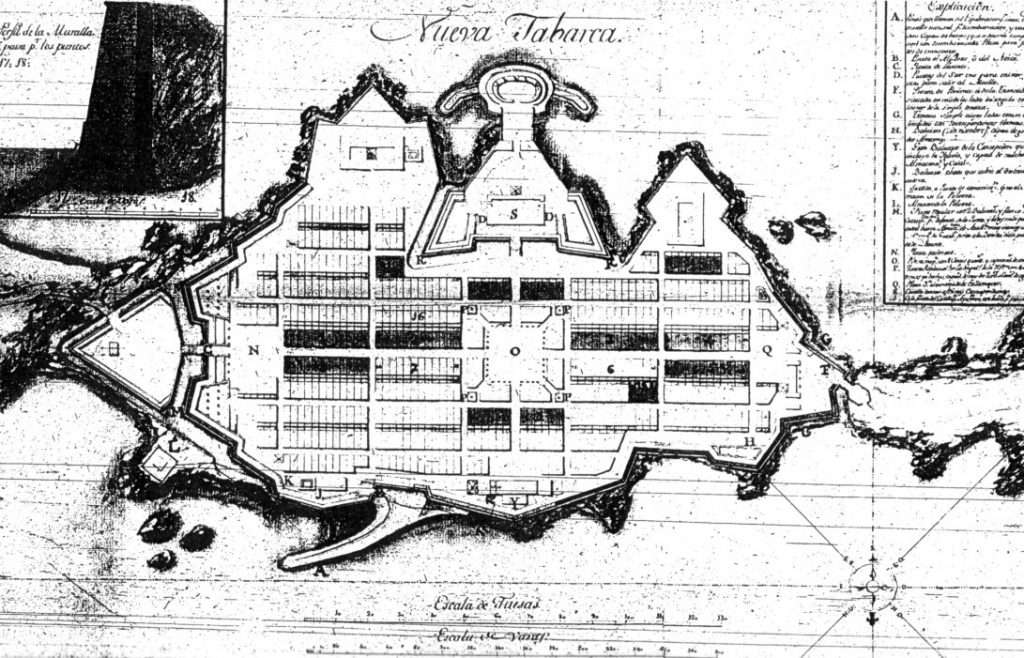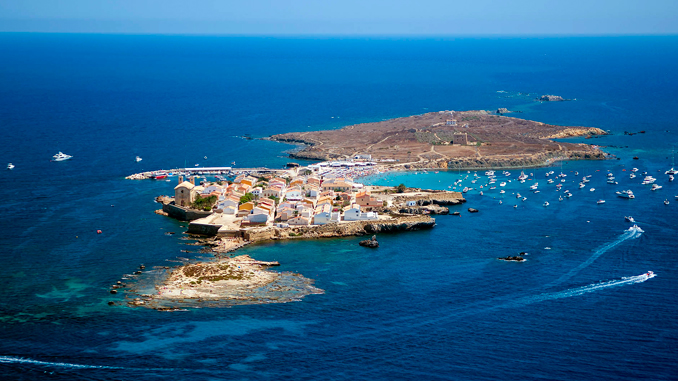Author: Pedro Ortega Montes
The island of Tabarca is an island located in the Mediterranean Sea, about 4 nautical miles from the port of Santa Pola and 12 from Alicante. This island is managed by the townhall of Alicante. It’s dimensions are 450m in width and 1800m in length, the island does not show large differences, the highest point being at 15m above sea level.
Based on archaeological remains found on the island, it is thought that it could be inhabited by Romans and Greeks, as far as the ground view of the island shows a hypodromic plant organizing the distribution of its streets by right angles. This suggests that perhaps the island was actually inhabited at least by Roman civilization following the classic Roman camp scheme where two main axes appear (Thistle and Decumanus) from which the rest of the streets.

Photo 01; First plan registered about the urbanization parto f the island. Reference: https://es.wikipedia.org/wiki/Archivo:1772~._Tabarca._Plano_del_Archivo_Hist%C3%B3rico_Nacional.jpg
Along the entire urban perimeter runs a wall which gives access to the city through the gate { Porta Llevant{ Porta de las Trancada}. In the city we also find a lighthouse at the easternmost end of the island, with a square plan rising in the center a prismatic tower for the lantern that gave the luminous signs.
In terms of population, this has undergone major changes from having 2000 inhabitants in 1780 to 57 according to INE data in 2016, this decrease has been motivated by the lack of jobs and opportunities in the area. The situation changes dramatically during the summer period, registering up to 10,000 visitors per day on the busiest summer days. The island has several hotels as well as restaurants, nautical activities, ornithological activities, diving and other activities.
The island is divided into two parts, one urbanised and the other not, as it is protected; it is an area of special importance for birds and nature reserve. As for the building part, the type of dwelling is of buildings of one or two floors of height, all very similar, except the bungalows built recently. The construction of the latter in the south-west of the island is particularly criticised. A total of 19 bungalows were built, of which 6 were declared illegal in 2003 by the High Court of Justice of the Valencian Community for not complying with the Coastal Law of the Valencian Community. This sentence was subsequently ratified by the Supreme Court in 2009, and the houses were demolished in 2016.
It is worth noting the precariousness of the public services offered by the island and how these are drastically reduced during the season in which the island receives a smaller influx of people, bordering on habitability limits.
Transportation is mainly by boat, except in urgent cases, where there is an area that can be used by a helicopter as a heliport. The regular transport service is covered by several large capacity private catamaran companies (250 people). The timetables of this service depend mainly on the season of the year, as it is a service focused entirely on tourism. In winter the trips are reduced to 4 trips in both directions daily with a cost of 15 euros. In summer the chaos produced by these boats in the small fishing port of the island is notorious. Since this port is free to dock and is often the result of the overcrowding of services, there are collisions between the vessels themselves. The reality of the island is that the majority of the inhabitants have to have a boat, owned or leased, in order to be able to live a normal life, to meet needs such as attending school for the island’s children.

Photo 02; Environment of the Tabarca’s Island. Reference: BLOG: https://torrevieja.com
Very few medical services are offered; in summer there is a doctor in addition to the Red Cross station on the beach. The problem lies mainly in the winter, as there are no qualified staff on the island to provide emergency medical services.The security services are also adapted to the number of people on the island, during the winter there is no police available except when needed at some scheduled event.
Waste management on the island is carried out by a vessel which periodically removes the waste produced and takes it to the peninsula for further treatment.
In 2017 the town council of Alicante approved a very important work for the island which was the construction of a series of pumps and pipes through which the waste water of the island can be transported (all of domestic type) to the city of Santa Pola, to properly treat waste in a waste water station. Until then, the waste was treated with very poor sieving and then discharged into the sea through an outfall at a distance of approximately 400m from the coastline. This seems to me to be an aberration in terms of the environment and hygiene, because of all the associated problems involved.
All the commentaries made about the island are understandable in that they are aimed at preserving the island’s heritage and at providing the island with minimum living conditions. Another work that is not allowed to be carried out and in my opinion would solve some of the problems produced by the lack of control of the port authority is the enlargement and modernization of the port. The municipality does not allow this work because the area is a marine reserve, although there are other cases in Spain where despite being located in a marine reserve and with less need than that raised in the example, they have been able to be carried out.
Pedro Ortega Montes
